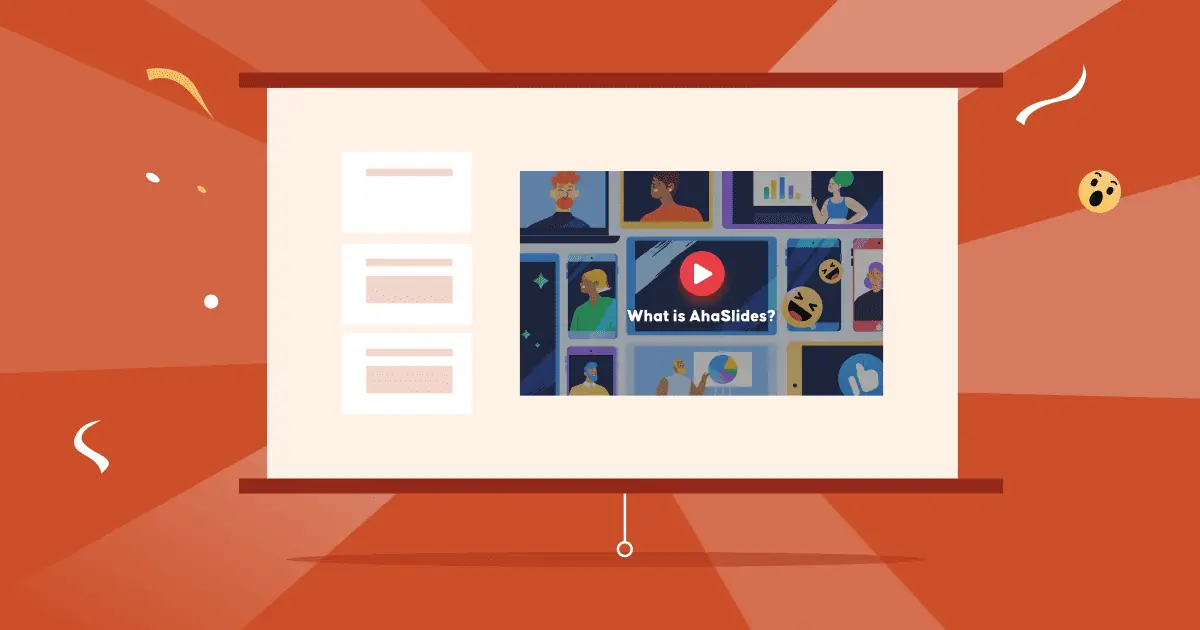Hur debatterar man för nybörjare? Att bråka är ett stort, stort ämne. Om du aldrig har bråkat förut kan det vara överväldigande att tänka på vad som kommer att hända och hur du kan undvika att se helt okunnig ut inför alla.
Det finns mycket att lära sig innan du kan ta mod till dig att stå på talarstolen. Men oroa dig inte; den här guiden till debatt för nybörjare ger dig stegen, tipsen och exemplen du behöver för att lyckas i din nästa debatt. Så, låt oss kolla in dessa fina debatttips!
Innehållsförteckning
- 7 steg för att skapa en debatt för nybörjare
- 10 tips för nya debattörer
- 6 stilar av debatter
- 2 Debattexempel
- Fler tips med AhaSlides
Fler tips med AhaSlides

Börja på några sekunder.
Få gratis mallar för studentdebatter. Registrera dig gratis och ta det du vill ha från mallbiblioteket!
🚀 Få gratis mallar ☁️
Hur en debatt för nybörjare fungerar (i 7 steg)
Innan du börjar formulera dina argument som ett proffs behöver du veta hur en nybörjardebatt fungerar. Kolla in dessa 7 steg till en debatt för nybörjare och vad du behöver göra längs vägen, så förstår du helt och hållet hur du blir en bättre debattör!
1. Syftet är beslutat

Eftersom vi kan använda debatter på många platser och i många situationer, till exempel i skolor, företagsmöten, paneldiskussioner eller politiska organ, är det avgörande att debattens huvudsyften väljs först. Detta kan ge en tydlig bild av planen och organisering av debatterna eftersom det finns många detaljer att arbeta med senare, vilka alla måste vara i linje.
Så, innan något annat, kommer handledaren att svara på detta – vad är syftet med denna debatt?
Till exempel, om du är i en studentdebatt, målen bör vara desamma som i din lektion, vilket kan vara att uppmuntra elevernas kritiska tänkande och förmåga att tala inför publik. Om det är på jobbet kan det vara att bestämma vilken av två idéer man ska välja.
2. Strukturen är vald
När man frågar sig hur man debatterar bra behöver man ha en struktur. Det finns många varianter av debattstrukturer där ute, och flera format inom dem. Det är viktigt att du känner till några grundläggande termer som används i många vanliga typer av debatter innan du förbereder dig för en debatt…
- Ämne – Varje debatt har ett ämne, som formellt kallas en rörelse or upplösningÄmnet kan vara ett uttalande, en policy eller en idé, det beror på debattens bakgrund och syfte.
- Två lag - Korrekt (stödjer motionen) och Negativ (motsätter sig motionen). I många fall består varje team av tre medlemmar.
- Domare or Domare: De personer som bedömer kvaliteten på argumenten i debattörernas bevis och prestationer.
- Tidmätare – Personen som håller koll på tiden och stoppar lagen när tiden är ute.
- observatörer – Det kan finnas åskådare (en publik) i debatten, men de får inte yttra sig.
För en nybörjardebatt, efter att ha mottagit motionen, kommer lagen att ha tid att förbereda sig. De Korrekt teamet börjar debatten med sin första talare, följt av den första talaren från Negativ team. Sedan går den till den andra högtalaren i Korrekt team, tillbaka till den andra talaren i Negativ team och så vidare.
Varje talare kommer att prata och framföra sina synpunkter på den tid som anges i debattreglerna. Tänk på att inte Alla Produkter Debatter avslutas med team Negativ; ibland, team Korrekt kommer att bli ombedd att avsluta.
Eftersom du förmodligen är nybörjare på detta, kan du hitta debattprocessen för nybörjare nedanDen är lätt att följa och kan användas i många olika typer av debatter.
3. Debattplanen är gjord
För att debatten ska flyta smidigt måste handledaren ha en plan som är så detaljerat som möjligtDe borde informera dig om den här planen, eftersom den hjälper till att visualisera allt och hindrar dig från att spåra ur, vilket är superenkelt att göra när man deltar i en nybörjardebatt.
Här är en enkel checklista över vad en plan bör innehålla:
- Syftet med debatten
- Strukturen
- Hur rummet kommer att vara inrett
- Tidslinjen och tidpunkten för varje period
- Formella debattregler och instruktioner för talare och domare
- Anteckningsmallar för rollerna
- Sammanfattningen för att avsluta debatten när den är slut
4. Rummet är arrangerat
Miljön är avgörande för en debatt eftersom den kan påverka talarnas prestationer i viss mån.
Din debatt bör ha en så professionell atmosfär som möjligt. Det finns många sätt att skapa ett debattrum, men oavsett vilken uppställning som väljs kommer allt att centreras kring "talarområdet" i mitten. Det är här all debattmagi kommer att ske.
Varje talare som representerar de två lagen kommer att stå i högtalarområdet under sin tur och sedan återgå till sin plats när de är klara.
Nedan följer en populärt layoutexempel för en nybörjardebatt:
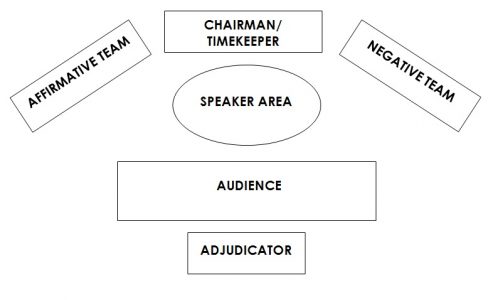
Naturligtvis finns det alltid möjlighet att hålla en debatt online. Du kanske har svårt att uppleva samma atmosfär som i en nybörjardebatt online, men det finns några sätt att krydda det:
- Bakgrundsanpassning: Varje roll kan ha olika Zoom-bakgrund: värd, tidtagare, domare och varje lag. Detta kan hjälpa till att skilja varje deltagares roller och inspirera till viss stolthet över den roll som ges.
- Stödutrustning:
- Timer: Timing är viktigt i en debatt, särskilt för nybörjare på sin första timeout. Din handledare kan besluta att hålla reda på ditt tempo med en timer på skärmen (även om tidtagaren i de flesta debatter bara signalerar när det är 1 minut eller 30 sekunder kvar).
- Ljudeffekter: Kom ihåg att detta bara är en debatt för nybörjare. Du kan förvänta dig att din facilitator lättar upp atmosfären med uppmuntrande klappande ljudeffekter när en talare avslutar sitt föredrag.
5. Lagen är utvalda
Lagen kommer att delas in i Korrekt och Negativ. Vanligtvis är teamen och talarpositionerna inom dessa team randomiserade, så din handledare kan använda en spinnerhjul för att göra processen mer spännande och engagerande.
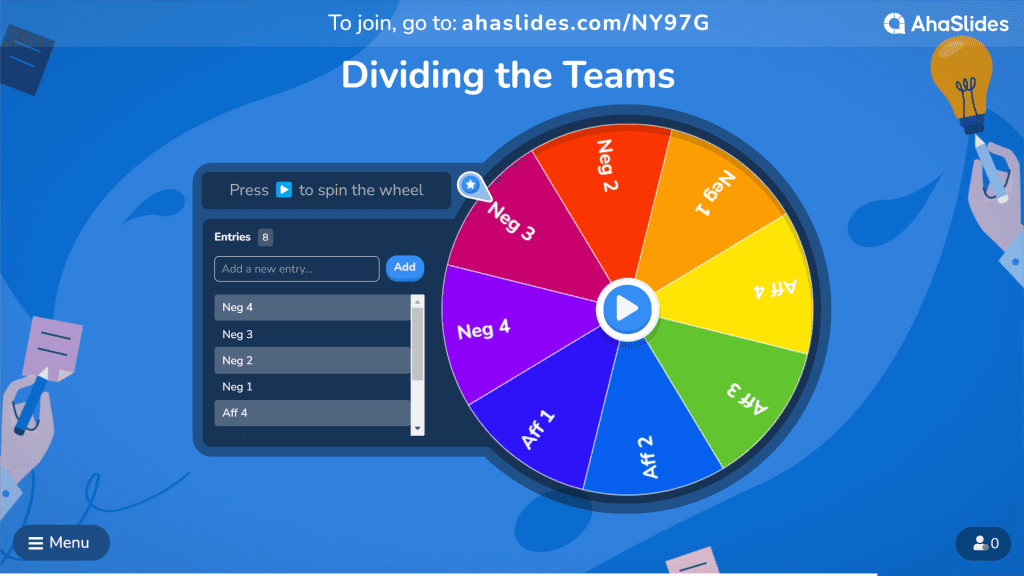
Efter att de två lagen har valts ut kommer förslaget att tillkännages och ni får lite tid att förbereda er, helst en timme.
Under denna tid kommer handledaren att peka ut många olika resurser så att teamen kan förstå sammanhanget och problemen för att göra starkare poäng. Ju mer du vet, desto livligare blir debatten.
6. Debatten startar
Varje typ av debatt kräver ett annat format, och det kan finnas många variationer. Nedan finns en mycket populär version som kan användas i alla debatter för nybörjare.
Varje lag har fyra gånger att tala i den här debatten, så det är bäst att ha 6 eller 8 talare. Om det är 6 talare kommer två debattörer att tala två gånger.
| Tal | Tid | Debattörernas ansvar |
| 1:a Bekräftande Konstruktiv | 8 min | Introducera rörelsen och deras synvinkel Ge deras definitioner av nyckelbegrepp Lägg fram sina argument för att stödja motionen |
| 1:a negativa konstruktiva | 8 min | Ange sina argument för att motsätta sig motionen |
| 2:a Bekräftande Konstruktiv | 8 min | Lägg fram ytterligare argument till stöd för förslaget och teamets åsikter Identifiera konfliktområden Svara på frågor från den negativa talaren (om någon) |
| 2:a negativa konstruktiva | 8 min | Lägg fram ytterligare argument mot förslaget och förstärk teamets åsikter Identifiera konfliktområden Svara på frågor från den jakande talaren (om någon) |
| 1:a negativa motbeviset | 4 min | Försvara Negativ lagets argument och motbevisa stödargumenten utan att lägga till nya argument eller information |
| 1:a bekräftande vederlag | 4 min | Försvara Korrekt lagets argument och besegra motståndarargumenten utan att lägga till nya argument eller information |
| 2:a negativa motbeviset (Slutförklaring) | 4 min | Har en andra motbevisning och avslutande uttalanden |
| 2:a bekräftande vederlaget (Slutförklaring) | 4 min | Har en andra motbevisning och avslutande uttalanden |
???? Det kan vara kort tid att förbereda sig innan motinvisningarna, beroende på reglerna.
Du kan se ett videoexempel på detta format här nere.
7. Bedöm debatten
Det är dags för domarna att arbeta. De behöver observera debatterna och varje debattörs framträdande och sedan bedöma. Det här är några av de saker de kommer att titta på i ditt framträdande…
- Organisation och tydlighet – Strukturen bakom ditt tal – är det vettigt att lägga upp det som du gjorde?
- Innehåll – Dessa argument, bevis, korsförhör och genmälen som du producerar.
- Leverans och presentationsstil – Hur du framför dina budskap, inklusive muntligt och kroppsspråk, ögonspråk och tonläge.
10 tips för nya debattörer
Ingen kan bemästra allt från början och om du aldrig har debatterat i ditt liv är det inte lätt att komma igång. Nedan följer 10 snabba tips att upptäcka hur man debatterar effektivt och kan följa med nybörjarna i varje debatt.
#1 - Förberedelser är nyckeln – Undersök ämnet mycket i förväg för att få inte bara bakgrundsinformation, utan också förtroende. Detta kan hjälpa nybörjardebattörer att förstå problemen bättre för att vara bra motbevisstartare, sedan formulera sina argument, hitta bevis och undvika att gå ner i kaninhålen. Varje debattör bör beskriva allt i punkter (helst 3 poäng för 3 argument) för att bättre ordna idéer och se den "stora bilden" av sitt tal.
#2 - Håll allt vid ämnet – En av debatternas synder är att spåra ur, eftersom det slösar bort värdefull talartid och försvagar argumentet. Var uppmärksam på dispositionerna och huvudpunkterna för att se till att de följer ämnet och tar upp rätt problem.
#3 - Gör dina poänger med exempel – Att ha exempel gör dina debattmeningar mer övertygande, och dessutom ser folk saker tydligare, som detta exempel nedan…
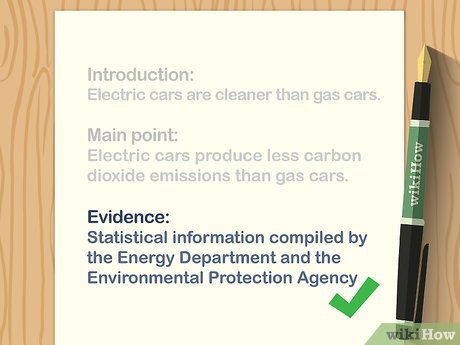
#4 - Försök att tänka som motståndarna – När du reviderar idéer, tänk på argument som oppositionen kan framföra. Identifiera några och skriv ner en tankekarta över genmälen som du skulle kunna erbjuda om de do sluta med att göra dessa poäng.
#5 - Ha en stark slutsats – Avsluta debatten med några bra meningar, som åtminstone kan sammanfatta huvudpunkterna. I många fall gillar debattörer att avsluta kraftfullt, med en poetiskt formulerad mening för att få det att hända. släpp för mikrofon ögonblick (kolla in ett exempel på detta nedan).
#6 - Var självsäker (eller fejka det tills du klarar det!) – En av de viktigaste sakerna för att bli bättre på att debattera är stämningen. Debattörer behöver vara säkra på vad de säger, eftersom skrytsamhet har stor inverkan på domare och observatörer. Naturligtvis, ju mer du förbereder dig, desto säkrare är du.
#7 - Tala långsamt – Ett mycket vanligt problem för nybörjardebattörer är deras talhastighet. Oftast går det alldeles för fort första gången, vilket orsakar oro hos både lyssnare och talare. Ta ett andetag och tala långsamt. Du kanske får ut mindre, men det du producerar kommer att ha tyngd.
#8 - Använd din kropp och ditt ansikte – Kroppsspråk kan stödja dina poänger och visa självförtroende. Se motståndarna i ögonen, ha en bra stående hållning och kontrollera ansiktsuttrycken (bli inte för aggressiv) för att fånga uppmärksamhet.
#9 - Lyssna noga och gör anteckningar – Debattörer måste vara uppmärksamma på varje tal och idé för att följa takten, stödja sina lagkamrater och bättre kunna motbevisa motståndarna. Att ha anteckningar kan vara till stor hjälp, eftersom ingen kan komma ihåg varje punkt för att motbevisa eller utveckla ytterligare. Kom ihåg att bara anteckna nyckelpunkter.
#10 - Undvik billiga bilder – Fokusera på och motbevisa dina motståndares argument, inte motståndarna själva. Inga debattörer ska vara kränkande mot andra; det visar på brist på professionalism och du kommer definitivt att bli nedvärderad för det.
6 stilar av nybörjardebatter
Det finns många stilar av debatter med olika format och regler. Att känna till några av dem ordentligt kan hjälpa nybörjardebattörer att se processen och vad de behöver göra. Här är några vanliga debattstilar du kan se i din första debatt!
1. Politisk debatt – Detta är en vanlig typ som kräver mycket forskning. Debatten kretsar kring huruvida man ska anta en viss policy eller inte, och oftast i form av två personer mer i teamet. Politisk debatt används i många skolor eftersom det är praktiskt och reglerna är lättare att följa än andra typer.
2. Riksdagsdebatt – Denna debattstil är baserad på den brittiska regeringens modell och debatterna i det brittiska parlamentet. Den antogs först av brittiska universitet, men är nu den officiella debattstilen för många stora debatttävlingar som World University Debating Championship och European Universities Debating Championship. Sådana debatter är kvicka och kortare än de traditionella. policy debatt, vilket gör den lämplig för många fall, från mellanstadier till universitet.
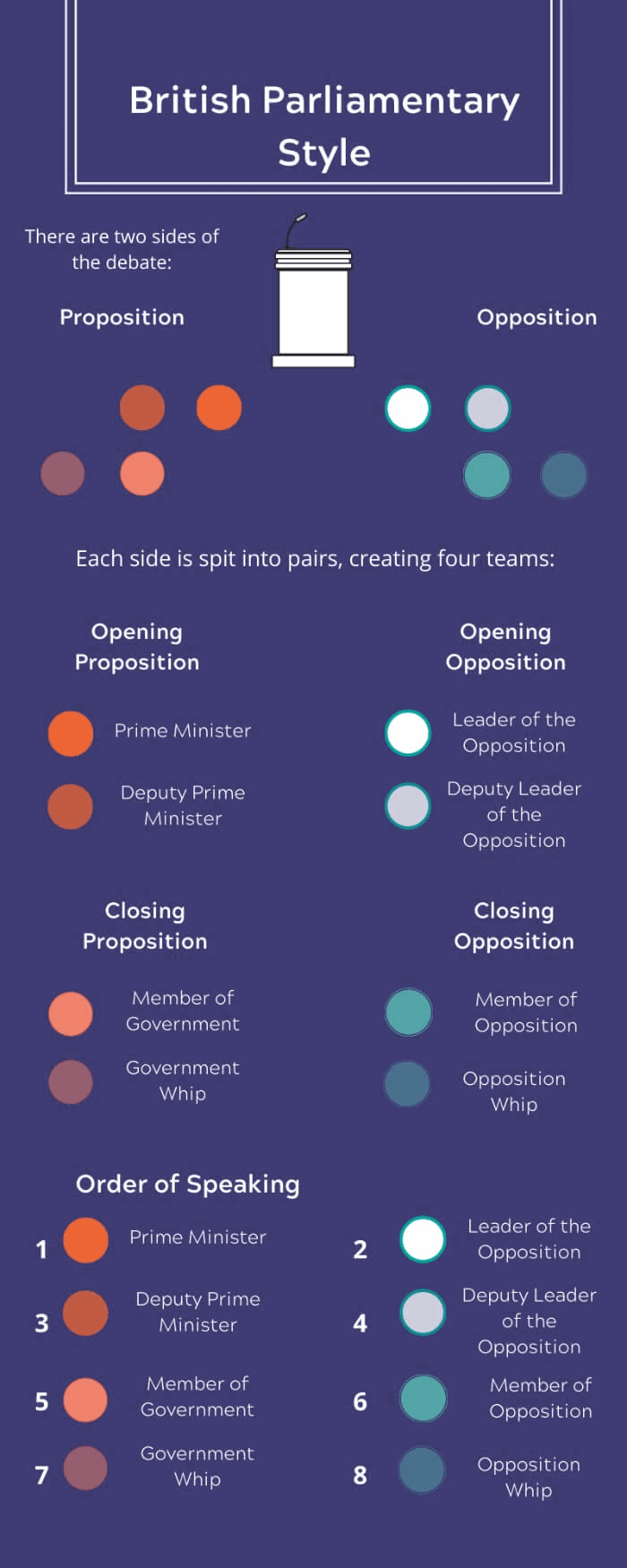
3. Offentlig forumdebatt – I den här stilen debatterar två lag några "heta" och kontroversiella ämnen eller aktuella frågor. Det är dessa ämnen som du förmodligen redan har en åsikt om, så den här typen av debatt är mer lättillgänglig än en policy debatt.
4. Lincoln Douglas diskussion– Detta är en öppen debattstil där man diskuterar enskilt, uppkallad efter en berömd serie debatter från 1858 mellan de amerikanska senatskandidaterna Abraham Lincoln och Stephen Douglas. I den här stilen fokuserar debattörerna på mer djupgående eller filosofiska frågor, främst om viktiga ämnen.
5. Spontan argument – Två debattörer argumenterar om ett specifikt ämne; de behöver formulera sina argument på mycket kort tid och snabbt bemöta motståndarnas idéer utan mycket förberedelse. Det kräver starka argumentationsförmågor och kan bidra till att stärka självförtroendet och övervinna scenskräck.
6. Kongress diskussion – Den här stilen är en simulering av den amerikanska lagstiftande församlingen, där debattörerna imiterar kongressledamöter. De debatterar lagförslag, inklusive lagförslag och resolutioner. Den skenande kongressen röstar sedan för att anta lagen och fortsätter att rösta för eller emot den.
2 Debattexempel
Här har vi två exempel på några debatter så att du bättre kan se hur de går till…
1. Brittiska parlamentets debatt
Detta är ett kort klipp från en debatt mellan den tidigare brittiska premiärministern Theresa May och den tidigare ledaren för Labourpartiet, Jeremy Corbyn. Debattens dynamiska atmosfär och hetsiga argument är typiska för den här typen av högljudd debatt. Dessutom avslutade May sitt tal med ett så starkt uttalande att hon till och med blev viral!
2. Debattörerna
Studentdebatter blir ett alltmer populärt fenomen i skolan; vissa väl genomförda debatter kan till och med vara lika engagerande som debatter från vuxna. Den här videon är ett avsnitt från ett engelskspråkigt vietnamesiskt debattprogram – The Debaters. Dessa gymnasieelever debatterade förslaget "Vi applåderar Greta Thunberg" i ett ganska vanligt 3-mot-3-format.





